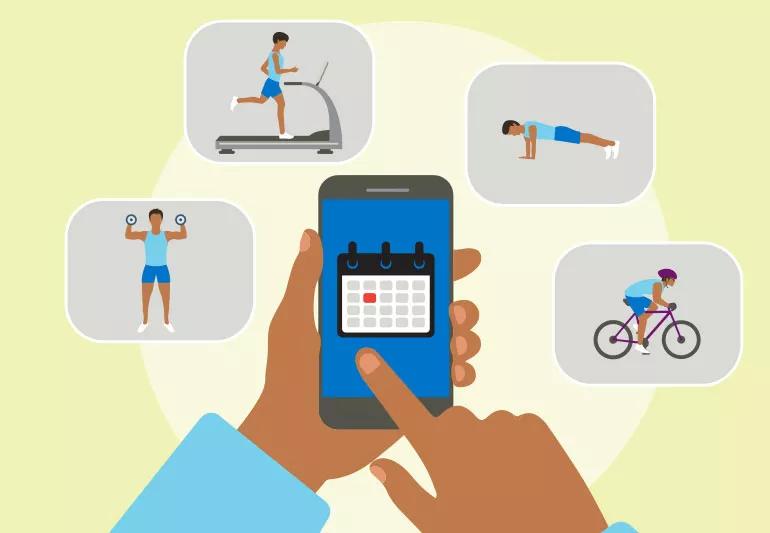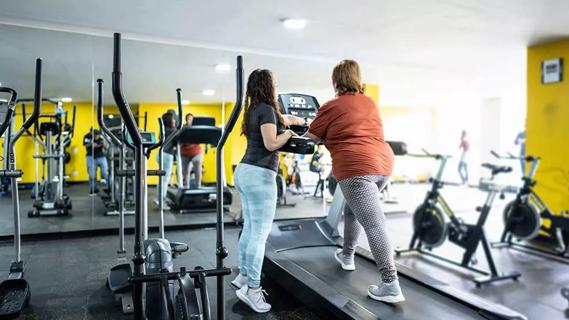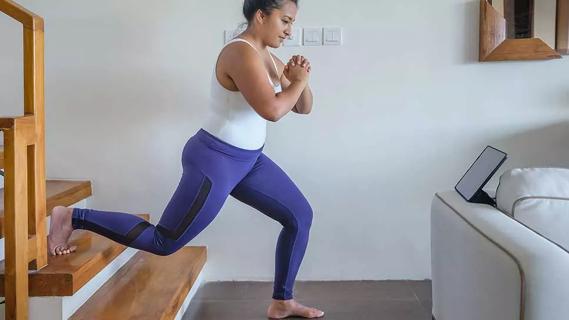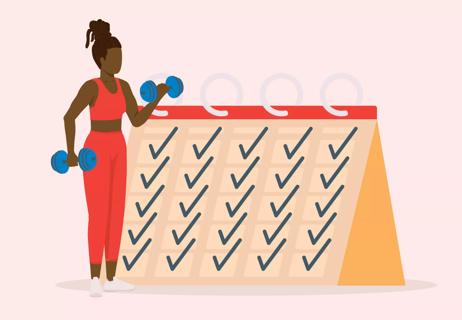Meet your workout goals by accounting for frequency, intensity, time and type

You know how important exercise is for your health. Keeping your body active is essential for preventing and managing chronic diseases like diabetes, high blood pressure, obesity and more. And the benefits of exercise on your mental health can’t be overstated.
Advertisement
Cleveland Clinic is a non-profit academic medical center. Advertising on our site helps support our mission. We do not endorse non-Cleveland Clinic products or services. Policy
But too often, we approach our fitness goals and plans a bit haphazardly. We know we should exercise, so we just … go for it.
But starting an exercise program without a solid plan doesn’t set you up for success.
“Exercise is medicine,” says sports medicine physician Michael Dakkak, DO. “And in order for medicine to be effective, you need to consider what you are taking, when, how much and for how long. The same thing goes for exercise. You need a plan.”
Enter, the FITT principle — a structure for helping you (and your healthcare team) devise an exercise routine tailored to your goals.
What is FITT and how do you get started? Dr. Dakkak explains.
You can think of the FITT principle as a prescription for exercise. FITT stands for frequency, intensity, time and type. That means considering:
“FITT is a way to design an exercise program that works for you,” Dr. Dakkak says. “If you don’t have a plan or don’t have a plan that works well for you, it’s easy to get off track. Having a solid plan is the first step to success.”
Consider this: If you have heart disease, a healthcare provider may recommend certain medications. But they don’t just say, “Take medicine.” They prescribe a specific medication. And then, they give you instructions on how much to take, when to take it and how long you should take it for.
Advertisement
Similarly, a provider may recommend exercise to help strengthen your heart. But, as with medication, you’ll benefit from guidance that’s more concrete than just, “Exercise more.”
Following the FITT principles to create a routine can ensure the exercise you’re doing will work for you. You can take into account how much time you can dedicate to exercise and what you enjoy doing.
FITT allows you to have a set plan to hold yourself accountable to. And it’ll ensure you don’t overdo things and leave yourself prone to injury.
“FITT principles help you to lay it all out in black and white so you know what you should be doing, when to do it, for how long and how hard to push yourself,” Dr. Dakkak explains. “Everybody’s goals and experience levels are different, but the nice thing about these principles is that they can be used by anybody, whether they’re beginner, intermediate or experienced.”
Let’s take a look at each of the elements of FITT and how they work together to create a prescription to fuel your fitness program.
Determining the frequency of your fitness routine is about solidifying a plan for how often you’ll exercise.
“The frequency of your exercise depends a lot on how much time you have to dedicate to exercise, what your goals are and what your fitness level is like currently,” Dr. Dakkak clarifies.
For example, if your workouts hinge mostly on lower-intensity activities like walking or swimming, you may consider doing those activities four to five times per week or even daily.
If you’re going to embark on more vigorous activities, like Zumba or HIIT (high-intensity interval training), you may consider taking the frequency down to something more like two or three sessions per week.
The intensity of your exercise program is a question of how much you’re getting your blood pumping. It’s essentially how hard your body is working to keep up.
“We measure the intensity of a workout based on heart rate zones,” Dr. Dakkak explains. “Your heart rate zone is a measure of how quickly your heart is beating. A higher heart rate during exercise means your heart is working harder.”
Knowing your exact heart rate zone takes a bit of math and a heart rate monitor. (You can learn how to calculate your heart rate zone here.) But you can also estimate what heart rate zone you’re in by gauging how you feel during your workout. Consider these signals:
Advertisement
During your workouts, your goal doesn’t have to be to push yourself to your zone 5-sweaty-panting-breaking-point. In fact, that shouldn’t be most people’s goal. Because the benefits of exercise start far below that threshold.
“For most people, we look to aim for their workouts to be in zones 2 or 3 for most of their exercise program,” Dr. Dakkak advises. “It’s not just about sweating, it’s about increasing VO2 max, which improves oxygenation and your cardiopulmonary system. You’re going to get benefits of that starting in zone two.”
What your intensity level should look like again depends on your goals and your other FITT principles.
If you’re working out regularly and for longer stretches, zone 2 may be perfect for you. But if you’re trying to squeeze in your exercise in shorter bursts (a la exercise snacks), you’ll want to ratchet up the intensity to reach your goals.
The American College of Cardiology (ACC) recommends that adults get at least 150 minutes per week of moderate-intensity exercise. Or at least 75 minutes a week of vigorous exercise. Or some combination of the two.
Additionally, the ACC recommends that adults do muscle-strengthening activities at least twice a week.
Advertisement
What exactly constitutes moderate versus vigorous exercise goes back to understanding your heart rate zone. Zones 2 and 3 are typically considered to be moderate exercise. Zones 4 and 5 are considered vigorous intensity.
Depending on your health goals, you may choose to meet those thresholds by taking a 30-minute walk five days a week. That comes out to 150 minutes of moderate intensity exercise.
Or maybe you’ll swim laps for 20 minutes a day for three days and do two (rather challenging) half-hour spin classes a week. That would equate to 60 minutes of moderate intensity exercise and 60 minutes of vigorous exercise. A good balance.
Or you could pack it all in with quick 15-minute sessions of HIIT five times a week for a total of 75 minutes of vigorous exercise.
The trick is knowing at least approximately where your heart rate is at and sustaining or increasing that rate in order to get full cardio benefits without risking injury.
“When you think about time, it’s also important to look at making sure that you have safe recovery periods, too,” Dr. Dakkak emphasizes. “If your plan is to allot your exercise time mostly to vigorous intensity exercise, that’s OK for some people. But you always want to make sure you’re taking enough time off to let your body rest. So, you’ll want to stick to shorter durations and be mindful of frequency.”
Advertisement
The type of exercise you do matters. A lot. It matters for your health goals and your level of fitness, of course. But Dr. Dakkak reminds us that it also matters because the type of exercises you choose will make a big difference in your success in maintaining your exercise program.
“It has to be fun,” he stresses. “I think fun is like a hidden ‘F’ in FITT. Because if you don’t enjoy it, it’s going to be next to impossible to keep up. If you’re miserable, you’re not going to keep doing it.”
When you consider the types of exercise to include in your exercise program, consider your goals, what’s accessible and feasible in your life, and what you actually like to do.
Here are some ideas:
Lower-intensity cardio exercise
Higher-intensity cardio exercise
Strengthening activities
“There are tons of activities that involve aerobic activity and strengthen your body,” Dr. Dakkak says. “The best type of exercise for you is whatever gets you moving and that you’ll be consistent doing. You have to be consistent with it, have fun with it and do it in a safe matter. That’s what we’re looking for.”
And make sure to get a mix of activity in whenever possible.
“If you’re just doing one thing, your body is going to be conditioned to that one thing,” he adds. “But your whole body needs your attention.”
Over time, your exercise program will need to undergo some maintenance.
Check in with how you’re doing at sticking to the plan. Keep a log of your exercise activities so you can be more mindful if you’re slipping off track. (And to congratulate yourself for a job well done!)
And be ready to adjust the plan as your body becomes more conditioned. Perhaps that walk around the block used to get your heart rate up. But after a few months, you may need to push a little more to get that same benefit.
“As your health improves, you’ll need to work harder to push your heart rate into higher zones, and that’s a good thing. It means your plan is working,” Dr. Dakkak says.
If your daily walk isn’t putting you into zone 2 anymore, you may need to calibrate one of your other FITT elements. Maybe it’s a question of time and you walk longer to get that heart rate up. Or you change up the type of exercise and turn that walk into a light jog.
When you go to tweak your plan, though, resist the temptation to make wholesale changes.
“I like to always say to only increase one thing at a time — whether that’s frequency, intensity or time,” Dr. Dakkak advises. “That’s really how we’re going to grow through the program and in our cardiovascular fitness and make sure that we’re not pushing our bodies too far too fast.”
Not sure where to start your FITT journey? Talk with a healthcare provider, like a sports medicine physician. They can help you develop a personalized plan tailored to your goals, your health and, perhaps most importantly, your life.
Learn more about our editorial process.
Advertisement

The exercise — which you’ve probably been doing since grade school — can be intimidating, but proper form can help

Exercise lowers risk for heart conditions, improves mental health and reduces visceral fat that can compromise your organs

Ask questions, get referrals and consider if someone is a good fit for you and your fitness goals

Expect a few bumps in the road, work out for the right reasons and give yourself some credit

Jump into the swing of things to improve your coordination, burn calories and get your heart rate going

Walking with a weighted backpack is a low-impact, full-body workout that’s growing in popularity

A super high heart rate means you’re burning more than fat

This modified challenge offers a head start on healthier habits

Type 2 diabetes isn’t inevitable with these dietary changes

Applying a hot or cold compress can help with pain